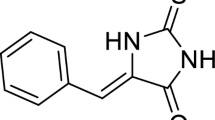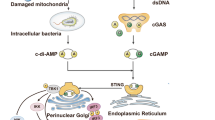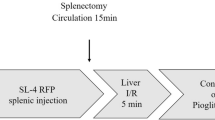Abstract
The root of Polygonum multiflorum Thunb (PM) has been used in China to treat a variety of diseases, such as constipation, early graying of the hair and hyperlipemia. Recent evidence shows that PM causes idiosyncratic drug-induced liver injury (IDILI) in humans. In this study, we investigated the molecular basis of PM-induced liver injury in a rat model of IDILI based on a non-hepatotoxic dose of LPS. SD rats were orally administered 3 potentially hepatotoxic compounds of PM: cis-stilbene glucoside (cis-SG, 50 mg/kg), trans-SG (50 mg/kg) or emodin (5 mg/kg), followed by injection of LPS (2.8 mg/kg, iv). Serum and liver histology were evaluated 7 h after LPS injection. Among the 3 compounds tested, cis-SG, but not emodin or trans-SG, induced severe liver injury in rats when combined with LPS. The levels of AST and ALT in plasma and inflammatory cytokines in both plasma and liver tissues were markedly elevated. The liver tissues showed increased injury, hepatocyte apoptosis, and macrophage infiltration, and decreased cell proliferation. Microarray analysis revealed a negative correlation between peroxisome proliferator-activated receptor-γ (PPAR-γ) and LPS/cis-SG-induced liver injury. Immunohistochemical staining and RT-PCR results further confirmed that cis-SG significantly inhibited activation of the PPAR-γ pathway in the liver tissues of LPS/cis-SG-treated rats. Pre-treatment with a PPAR-γ agonist pioglitazone (500 g/kg, ig) reversed LPS/cis-SG-induced liver injury, which was associated with inhibiting the nuclear factor kappa B (NF-κB) pathway. These data demonstrate that cis-stilbene glucoside induces immunological idiosyncratic hepatotoxicity through suppressing PPAR-γ in a rat model of IDILI.
Similar content being viewed by others
Log in or create a free account to read this content
Gain free access to this article, as well as selected content from this journal and more on nature.com
or
Change history
22 December 2020
A Correction to this paper has been published: https://doi.org/10.1038/s41401-020-00592-2
References
Dong Q, Li N, Li Q, Zhang CE, Feng WW, Li GQ, et al. Screening for biomarkers of liver injury induced by Polygonum multiflorum: a targeted metabolomic study. Front Pharmacol 2015; 6: 217.
Park HJ, Zhang N, Park DK . Topical application of Polygonum multiflorum extract induces hair growth of resting hair follicles through upregulating Shh and beta-catenin expression in C57BL/6 mice. J Ethnopharmacol 2011; 135: 369–75.
Yu J, Xie J, Mao XJ, Wang MJ, Li N, Wang J, et al. Hepatoxicity of major constituents and extractions of Radix Polygoni Multiflori and Radix Polygoni Multiflori Praeparata. J Ethnopharmacol 2011; 137: 1291–9.
Dong H, Slain D, Cheng J, Ma W, Liang W . Eighteen cases of liver injury following ingestion of Polygonum multiflorum. Complement Ther Med 2014; 22: 70–4.
Wu X, Chen X, Huang Q, Fang D, Li G, Zhang G . Toxicity of raw and processed roots of Polygonum multiflorum. Fitoterapia 2012; 83: 469–75.
Sun J, Huang X, Wu H, Huang F . Determination of content and light stability of cis-and trans-2, 3, 5, 4′-tetrahydroxystilbene-2-O-β-D-glucoside in Radix Polygoni multiflori by RRLC/DAD/MS. Chin Pharm J 2009; 44: 541–4.
Camont L, Cottart CH, Rhayem Y, Nivet-Antoine V, Djelidi R, Collin F, et al. Simple spectrophotometric assessment of the trans-/cis-resveratrol ratio in aqueous solutions. Anal Chim Acta 2009; 634: 121–8.
Unsalan O, Kus N, Jarmelo S, Fausto R . Trans- and cis-stilbene isolated in cryogenic argon and xenon matrices. Spectrochim Acta A Mol Biomol Spectrosc 2015; 136: 81–94.
O'Brien JM, Austin AJ, Williams A, Yauk CL, Crump D, Kennedy SW . Technical-grade perfluorooctane sulfonate alters the expression of more transcripts in cultured chicken embryonic hepatocytes than linear perfluorooctane sulfonate. Environ Toxicol Chem 2011; 30: 2846–59.
Ichihara G, Li W, Shibata E, Ding X, Wang H, Liang Y, et al. Neurologic abnormalities in workers of a 1-bromopropane factory. Environ Health Perspect 2004; 112: 1319–25.
Sun X, Sun Y, Li H, Sun W . Influence of main component of Heshouwu such as emodin, rhein and toluylene glycoside on hepatic cells and hepatoma carcinoma cells. Modern J Integr Tradit Chin Western Med 2010; 19: 1315–17.
Lei X, Chen G, Chen K, Li J . Acute toxicity studies of emodin in mice. Pharmacol Clin Chin Mat Med 2008; 24: 29.
Empey PE . Genetic predisposition to adverse drug reactions in the intensive care unit. Crit Care Med 2010; 38: S106–16.
Li C, Li X, Tu C, Li N, Ma Z, Pang J, et al. The idiosyncratic hepatotoxicity of Polygonum multiflorum based on endotoxin model. Yao Xue Xue Bao 2015; 50: 28–33.
Luyendyk JP, Maddox JF, Cosma GN, Ganey PE, Cockerell GL, Roth RA . Ranitidine treatment during a modest inflammatory response precipitates idiosyncrasy-like liver injury in rats. J Pharmacol Exp Ther 2003; 307: 9–16.
Roth RA, Luyendyk JP, Maddox JF, Ganey PE . Inflammation and drug idiosyncrasy—is there a connection? J Pharmacol Exp Ther 2003; 307: 1–8.
Roth RA, Harkema JR, Pestka JP, Ganey PE . Is exposure to bacterial endotoxin a determinant of susceptibilityto intoxication from xenobiotic agents? Toxicol Appl Pharmacol 1997; 147: 300–11.
Li CY, Niu M, Bai ZF, Zhang CN, Zhao YL, Li RY, et al. Screening for main components associated with the idiosyncratic hepatotoxicity of a tonic herb, Polygonum multiflorum. Front Med 2017; 11: 253–65. doi: 10.1007/s11684-017-0508-9.
Li SF, Zheng CZ, Zhang L, Yao WF, Lan CW, He DX, et al. Effect of harvest seasons on main bioactive constituents in Polygoni Multiflori Radix. Modern Chin Med 2015; 17: 1177–83.
Luyendyk JP, Lehman-McKeeman LD, Nelson DM, Bhaskaran VM, Reilly TP, Car BD, et al. Coagulation-dependent gene expression and liver injury in rats given lipopolysaccharide with ranitidine but not with famotidine. J Pharmacol Exp Ther 2006; 317: 635–43.
Ogawa Y, Yoneda M, Tomeno W, Imajo K, Shinohara Y, Fujita K, et al. Peroxisome proliferator-activated receptor gamma exacerbates concanavalin a-induced liver injury via suppressing the translocation of NF-kappaB into the nucleus. PPAR Res 2012; 2012: 940384.
Clark RB . The role of PPARs in inflammation and immunity. J Leukoc Biol 2002; 71: 388–400.
Faure E, Equils O, Sieling PA, Thomas L, Zhang FX, Kirschning CJ, et al. Bacterial lipopolysaccharide activates NF-kappaB through toll-like receptor 4 (TLR-4) in cultured human dermal endothelial cells. Differential expression of TLR-4 and TLR-2 in endothelial cells. J Biol Chem 2000; 275: 11058–63.
Pascual G, Fong AL, Ogawa S, Gamliel A, Li AC, Perissi V, et al. A SUMOylation-dependent pathway mediates transrepression of inflammatory response genes by PPAR-gamma. Nature 2005; 437: 759–63.
Enomoto N, Takei Y, Hirose M, Konno A, Shibuya T, Matsuyama S, et al. Prevention of ethanol-induced liver injury in rats by an agonist of peroxisome proliferator-activated receptor-gamma, pioglitazone. J Pharmacol Exp Ther 2003; 306: 846–54.
Han Z, Zhu T, Liu X, Li C, Yue S, Liu X, et al. 15-Deoxy-Delta12,14 -prostaglandin J2 reduces recruitment of bone marrow-derived monocyte/macrophages in chronic liver injury in mice. Hepatology 2012; 56: 350–60.
Ganey PE, Roth RA . Concurrent inflammation as a determinant of susceptibility to toxicity from xenobiotic agents. Toxicology 2001; 169: 195–208.
Roth RA, Luyendyk JP, Maddox JF, Ganey PE . Inflammation and drug idiosyncrasy–is there a connection? J Pharmacol Exp Ther 2003; 307: 1–8.
Waring JF, Liguori MJ, Luyendyk JP, Maddox JF, Ganey PE, Stachlewitz RF, et al. Microarray analysis of lipopolysaccharide potentiation of trovafloxacin-induced liver injury in rats suggests a role for proinflammatory chemokines and neutrophils. J Pharmacol Exp Ther 2006; 316: 1080–7.
Buchweitz JP, Ganey PE, Bursian SJ, Roth RA . Underlying endotoxemia augments toxic responses to chlorpromazine: is there a relationship to drug idiosyncrasy? J Pharmacol Exp Ther 2002; 300: 460–7.
Xaus J, Comalada M, Valledor AF, Lloberas J, Lopez-Soriano F, Argiles JM, et al. LPS induces apoptosis in macrophages mostly through the autocrine production of TNF-alpha. Blood 2000; 95: 3823–31.
Scher JU, Pillinger MH . 15d-PGJ2: the anti-inflammatory prostaglandin? Clin Immunol 2005; 114: 100–9.
Zingarelli B, Sheehan M, Hake PW, O'Connor M, Denenberg A, Cook JA . Peroxisome proliferator activator receptor-gamma ligands, 15-deoxy-Delta(12,14)-prostaglandin J2 and ciglitazone, reduce systemic inflammation in polymicrobial sepsis by modulation of signal transduction pathways. J Immunol 2003; 171: 6827–37.
Standiford TJ, Keshamouni VG, Reddy RC . Peroxisome proliferator-activated receptor-{gamma} as a regulator of lung inflammation and repair. Proc Am Thorac Soc 2005; 2: 226–31.
Liu D, Zeng BX, Shang Y . Decreased expression of peroxisome proliferator-activated receptor gamma in endotoxin-induced acute lung injury. Physiol Res 2006; 55: 291–9.
Li CC, Yang HT, Hou YC, Chiu YS, Chiu WC . Dietary fish oil reduces systemic inflammation and ameliorates sepsis-induced liver injury by up-regulating the peroxisome proliferator-activated receptor gamma-mediated pathway in septic mice. J Nutr Biochem 2014; 25: 19–25.
Zhou M, Wu R, Dong W, Jacob A, Wang P . Endotoxin downregulates peroxisome proliferator-activated receptor-gamma via the increase in TNF-alpha release. Am J Physiol Regul Integr Comp Physiol 2008; 294: R84–92.
Acknowledgements
This work was supported by the National Natural Science Foundation of China (No 81503350 and 81630100), the "Major Drug Discovery" Science and Technology major projects (No 2015ZX09501-004-001-008), the National Public Welfare Industry Subject (No 201507004-04), the Beijing Natural Science Foundation (No 7152142), and the Beijing Nova Program (No xx2016098).
Author information
Authors and Affiliations
Corresponding authors
Additional information
Supplementary information are available on the website of Acta Pharmacologica Sinica.
Supplementary information
Supplementary data
Supplementary data (DOC 87 kb)
Supplementary Table S1
the differential toxicity of Cis-SG, Trans-SG on the parenchymal hepatic cells (DOC 89 kb)
Supplementary Table S2
Down-expressed genes of Cis-SG vs Trans-SG (DOC 278 kb)
Supplementary Table S3
up- expressed genes of Cis-SG vs Trans-SG (DOC 160 kb)
Supplementary Table S4
The pathway of mRNA differential expression gene (DOC 194 kb)
Supplementary Table S5
The pathway of mRNA differential expression gene of Cis-SG vs Trans-SG (DOC 107 kb)
Rights and permissions
About this article
Cite this article
Meng, Yk., Li, Cy., Li, Ry. et al. Cis-stilbene glucoside in Polygonum multiflorum induces immunological idiosyncratic hepatotoxicity in LPS-treated rats by suppressing PPAR-γ. Acta Pharmacol Sin 38, 1340–1352 (2017). https://doi.org/10.1038/aps.2017.32
Received:
Accepted:
Published:
Issue date:
DOI: https://doi.org/10.1038/aps.2017.32
Keywords
This article is cited by
-
Efficacy of Bushen Qudu Formula in the treatment of uremic pruritus in patients undergoing hemodialysis
International Urology and Nephrology (2025)
-
The deglycosylated metabolite of 2,3,5,4′-tetrahydroxystilbene-2-O-β-D- glucoside contributes to immune-mediated hepatotoxicity induced by Polygonum multiflorum
Archives of Toxicology (2025)
-
Separation of three flavonoid glycosides from Polygonum multiflorum Thunb. leaves using HSCCC and their antioxidant activities
European Food Research and Technology (2022)
-
Investigation of the idiosyncratic hepatotoxicity of Polygonum multiflorum Thunb. through metabolomics using GC-MS
BMC Complementary Medicine and Therapies (2021)
-
The hepatotoxicity of Polygonum multiflorum: The emerging role of the immune-mediated liver injury
Acta Pharmacologica Sinica (2021)



